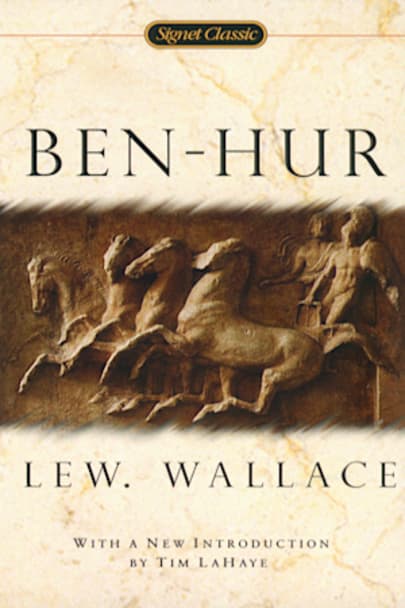One of the most popular American novels of all time, General Lew Wallace’s Ben-Hur vividly reimagines the mighty Roman Empire and the rise of Christianity. The saga of Judah Ben-Hur’s spiritual journey from slavery to vengeance to redemption is both a vivid historical adventure and a powerful story of one man’s religious awakening. As Blake Allmendinger writes in his Introduction to this Modern … this Modern Library Paperback Classic, “Ben-Hur has endured for more than one hundred years because it offers something for everyone. The story of the Jewish hero Ben-Hur, his conflict with the Roman warrior Messala, and his conversion to Christianity at the foot of the Cross, combines adventure, sentimentality, athletic spectacle, and religious devotion.”
more



BILLY THE KID MET BEN HUR?? ABSOLUTELY!!
1880.
Billy was an outlaw.
Lew Wallace (he wrote Ben Hur) was the Governor of the New Mexico Territory.
The West was wild in 1880 in Lincoln County, New Mexico. William H Bonney — alias Billy the Kid — was a hot-headed horse thief and cattle rustler who got in the middle of a range war between two rival ranching interests in Lincoln County. Billy thought he was unfairly indicted for a murder and contacted New Mexico Territorial Governor Lew Wallace, looking for a deal. Apparently, Governor Wallace agreed.
Billy’s troubles escalated until he was eventually tried and convicted in Mesilla, NM, in early 1881. In a last-gasp effort to free himself, he wrote again to Governor Wallace in Santa Fe, asking the Gov to uphold his promise for clemency from a year ago. The Gov declined. By then, Billy the Kid was too notorious
Governor Wallace was a colorful western character himself. A few months before, in November, 1880, he’d published his second novel, a Tale of the Christ called BEN HUR. Sales were not great. In its first 7 months, Ben Hur had sold less than 3,000 copies. But Billy had the reputation as the biggest outlaw in the country, and his arrest and conviction had captivated the country. Pat Garrett arrested Billy (and eventually shot him dead after an escape) but Gov Wallace took a little credit himself. Publicity was good for the Gov who stopped Billy the Kid.
Book sales increased. By 1900, BEN HUR had sold over a million copies! In 1913, Sears Roebuck ordered a million copies themselves, and sold each one for 39 cents. BEN HUR became the single best selling book in history, surpassing Uncle Tom’s Cabin. By 1946, over 26 million copies were in print. BH was passed when Gone With the Wind reached #1 in sales in 1936, But after BH the movie was released in 1960 (11 academy awards) BH the book took off again and reclaimed its position as the number one selling book of all time.
I don’t know how I could be so uninformed about this aged book. I know that as a child I saw the movie, but was bored with its length, unfamiliar dialect, and even the subject matter. However, as I now read the book, those glorious scenes replayed in my mind, giving new life to the story. Moreover, the Christ story so resonated throughout the journey of the fictional Ben Hur.
My copy of Ben-Hur is over 50 years old – broken spine; brown, brittle pages; looks like it was written on a type-writer. It belonged to my father, who had an entire collection of books from the same publisher – Bancroft Classic. I’ve inherited this one, as well as Robinson Crusoe and A Tale of Two Cities. This one, I’ve been meaning to read the longest.
Ben-Hur follows the story of Judah, Prince of Jerusalem of the house of Hur, a young Jewish man who is wrongly accused of the attempted murder of a Roman General by a man he thought was his friend. After spending years as a galley slave, rowing the boat of another Roman General, Judas is set free and adopted by a Roman whom he saves from drowning. The rest…well, the rest is spoilers.
The novel ties in historical happenings around the time of Roman-Judea to the life of the infamous Jesus Christ. In fact, the whole novel is framed by his life and death. Judas, a faithful Jew, encounters Jesus Christ (and those affected by him) multiple times throughout the story, and it becomes most prominent at the very end.
The whole novel is, therefore, a very Christian tale. You can tell it is by the way Wallace wrote about people’s interactions with Jesus, and the way the miracles are portrayed. Rather than being a purely historical tale, the whole thing stinks of Christian propaganda and the teachings the religion brings.
Now, I’m not the most religious person in the world, but I did enjoy reading this. While the whole thing felt a bit like a morality tale at parts, and the glorification of the Christ figure is a bit too much for my taste, it’s still a classic that deserves to be read.
So, I did just that.
Final Rating: 3/5 – Not a waste of time to read, but I wouldn’t recommend it to just anyone.